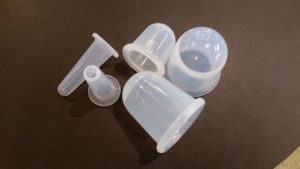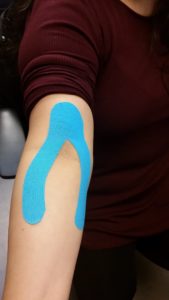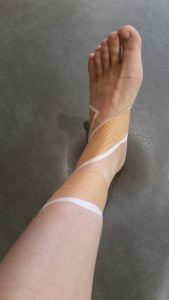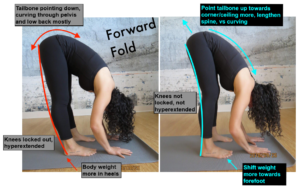| Common areas of hypermobility:
· Knee hyperextension – knees locked out and bent too far back, beyond straight · Pelvis rounded, abdominals not active
|
How to control:
· Knee hyperextension – soft knees, don’t lock knees out · Aim tailbone up towards the ceiling more, abdominals active, lengthen spine vs rounding spine
|
Author: Admin Good Health
Cupping
What is cupping?
Cupping is one way that can help with myofascial release. Myofascial release (MFR) is a technique that many physical therapists at Good Health Physical Therapy & Wellness utilize when treating our patients. There are different types of MFR, and cupping is one that has been in the spotlight recently. While we don’t use the traditional heated glass cups,  we have silicon cups that are softer. When used with lotion or oil, they can slide around over the tissues, lifting and pulling layers of tissue up and apart. This helps increase the space for improving blood flow and increasing the mobility of different tissues layers. The better these layers of tissues move in general, and in relation to each other, the healthier the tissue can be. This technique often results in improved mobility, reduced pain, and helps with healing.
we have silicon cups that are softer. When used with lotion or oil, they can slide around over the tissues, lifting and pulling layers of tissue up and apart. This helps increase the space for improving blood flow and increasing the mobility of different tissues layers. The better these layers of tissues move in general, and in relation to each other, the healthier the tissue can be. This technique often results in improved mobility, reduced pain, and helps with healing.
When do we use cupping techniques?
Cupping is often used to promote healing of tissue injuries such as sprains, strains, and partial tears. It can be used for any condition from shoulder pain, rotator cuff injury, low back pain, neck pain, headaches, and many others. It is often used to improve range of motion and mobility of a joint, decrease compression. It is then is followed up by stretching, foam roller, and strengthening programs prescribed specifically for patients based on their symptoms and goals.
Sometimes, they can leave little marks/bruises. This usually happens over especially tight and restricted areas, but this just means it’s an area that really needs it!
If you think you might benefit from this type of treatment, or would like to find out if you would, contact us at Good Health Physical Therapy & Wellness!
Yoga Workshop Wednesday – Mountain Pose
| Common areas of hypermobility:
· Lumbar spine hyperextension and anterior pelvic tilt- low back too arched back, pelvis tilted forward · Knee hyperextension – knees locked out and bent too far back, beyond straight · Head and neck hyperextension – head and neck hanging back, chin up |
How to control:
· Lumbar hyperextension and anterior pelvic tilt: tuck tail bone down towards the ground using gluts and bring pubic bone tucked up using lower abs · Don’t lock out knees, keep knees ‘soft’. · Control head and neck posture, try to keep chin down towards throat more, gaze will not be as straight up
|
What is the difference between Kinesio®tape and athletic tape?
Cueing vs stability
Kinesio® tape is stretchy compared to athletic and Leukotape®. Each are great and beneficial, but for very different purposes.
The stretchy quality of Kinesio® tape provides cues for better joint alignment and position, muscle activation, and posture. As your body moves into these positions, the tape will stretch, giving you a cue to reduce the tension of the tape and return to the better posture and alignment. The stretch of the tape can also be used to help lift the skin, allowing more blood flow. It has been shown to help reduce swelling and help with soft tissue healing.
Other kinds of more traditional tape are used for stabilization. Because of its less stretchy nature, athletic tape will prevent movement into poor positions all together, not allowing you to move out of a certain alignment.
How do you know if Kinesio® tape or athletic tape would be best for you?


The best way to know would be to see a physical therapist to assess what is happening with your posture or joint alignment. We are trained in the different techniques, patterns, and ways to cut and apply the tape to provide the best benefit and proper purpose of the tape.
For a quick answer though, if you are looking for more stability like a temporary brace, then athletic or Leukotape® are best. If you are trying to retrain yourself to use the right muscles and maintain a certain posture or alignment, then Kinesio® tape is best.
We recommend seeing a physical therapist for the other more medical applications of Kinesio® tape such as to reduce swelling or increase blood flow to an injured area for healing.
A physical therapist at Good Health Physical Therapy & Wellness is always happy to provide more information or assess your needs to reduce or prevent pain and injury
Oregon is a direct access state for physical therapy. What does this mean for you?
Many people think that you need a doctor’s referral to get specialized care. People often see their primary care physician first for any ailment, and your doctor directs you to the right specialist for further investigation and diagnosis. Recently, with rising healthcare costs and a change in physical therapy training, many states now allow direct access. This means if you have a condition involving your muscles or joints you have the right to see a physical therapist (a musculoskeletal specialist) without a referral from your doctor. This can depend on your insurance policy, however. While this is not a federal law, several states have some version of direct access. Oregon is one of them!
According to a 2016 article in the American Physical Therapy Association’s magazine, PT in Motion, Oregon is one of several states that provide unrestricted direct access. A study done by the American Physical Therapy Association has shown the same quality of care, no adverse events and lower cost for patients who saw a physical therapist through direct access compared to those who went to a primary care provider first.
Physical therapists are trained to rule in and rule out red flag signs and symptoms. If we are in doubt about a diagnosis, then we refer you back to a medical doctor to receive the appropriate care. More often, though, people see their doctor for a muscle or joint condition and are then referred to a physical therapist. Direct access allows you to skip a step, make one less appointment, save money, and go directly to the person who can treat your symptoms. You wouldn’t go to a physical therapist first for a sore throat, and you shouldn’t go to your primary care provider first for a pulled muscle.
So, if you think you have a musculoskeletal injury, see your physical therapist first! Start by calling our office (503)292-5882 and our helpful staff will get you an appointment. They can check your insurance company’s requirements/coverage or explain more about our reasonable cash pay rates.
Chie Tadaki, PT, DPT

Great Fall Sport Warmup
Dynamic Warm-Ups and Static Stretching
Dynamic Warm-ups and good stretching is critical for successful participation in sports. Click the link above for a warm up we love.

Now Offering Pelvic Floor Treatment for Pain and Tension Syndromes
The John F. Barnes’ Myofascial Release Approach is considered to be the ultimate mind/body therapy that is safe, gentle and consistently effective in producing results that last. Read More

ACL Tear-how to prevent one or heal quickly after
Check back for some great information!
What is Integrative Manual Therapy?
Introduction
Integrative Manual Therapy (IMT™) is a unique set of techniques, approaches, and methodologies that address pain, dysfunction, disease and disability. Developed by Dr. Sharon W. Giammatteo, IMT is best described as a health care process. IMT encompasses a wide range of health care practices. It achieves health and healing by taking into account the diverse systems of the human body and addressing dysfunction at the cellular level. IMT practitioners use their hands (among other tools) to diagnose and treat clients. With practitioners around the world, IMT offers clients the opportunity for healing, recovery and rehabilitation as an alternative and/or complement to invasive (surgical) procedures or aggressive (pharmaceutical) methods. Read More



